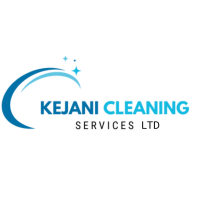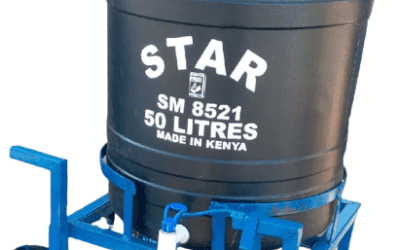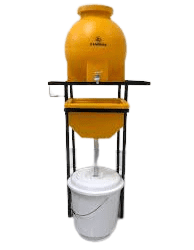Introduction
In workplaces, schools, restaurants, hospitals, and construction sites, proper hand hygiene isn’t optional—it’s a regulatory and health requirement. A handwashing station ensures that individuals have a designated, sanitary place to wash their hands regularly, reducing the spread of illness and keeping environments safe.
In this article, we break down:
-
What is required for a handwashing station
-
OSHA requirements for hand wash stations
-
Local best practices in Kenya
-
And why compliance isn’t just smart—it’s essential.
What is a Requirement for a Handwashing Station?
To function properly and promote hygiene, every handwashing station must meet the following minimum requirements:
✅ 1. Clean Running Water
-
Must supply clean, potable (drinkable) water.
-
Can be piped or delivered from a tank in portable units.
-
Must not be stagnant or contaminated.
✅ 2. Soap Supply
-
Either liquid soap in a dispenser, bar soap in a holder, or foaming soap.
-
Must be consistently replenished to ensure handwashing effectiveness.
✅ 3. Hand-Drying Option
-
Paper towels, cloth towels (single-use), or air dryers.
-
No handwashing station is complete without drying mechanisms.
✅ 4. Wastewater Management
-
Used water must be drained safely into a proper container or plumbing system.
-
Portable units should have a separate tank for wastewater.
✅ 5. Signage and Instructions
-
Clear signage should indicate that the station is for handwashing.
-
Visual guides on proper handwashing technique are encouraged.
✅ 6. Accessibility
-
Stations should be placed in easily accessible, visible locations.
-
Should accommodate both adults and children where necessary.
OSHA Requirements for Hand Wash Stations
The Occupational Safety and Health Administration (OSHA), under Kenya’s Directorate of Occupational Safety and Health Services (DOSHS), provides minimum hygiene standards for workplace sanitation. Below are key OSHA handwashing station requirements:
🛠️ 1. Adequate Number of Handwashing Stations
-
For every 20 workers, at least 1 handwashing station must be provided.
-
For food handling, handwashing stations must be close to food prep and service areas.
🛠️ 2. Stations Must Be Functional at All Times
-
A non-operational station is considered a hazard.
-
Employers must inspect and maintain them regularly.
🛠️ 3. Handwashing Stations Must Be Separate from Toilets
-
OSHA emphasizes that hygiene stations must not be placed inside toilet cubicles but should be near toilets for easy access.
🛠️ 4. Facilities Must Be Equipped With:
-
Water (running or from foot pump systems)
-
Soap or detergent
-
Sanitary drying methods (no common-use towels)
-
Covered waste bins for paper towels
🛠️ 5. Hand Sanitizer Alone is NOT a Substitute
-
Unless water is unavailable, alcohol-based sanitizers may only supplement—not replace—soap and water.
Additional Kenyan Regulations & Best Practices
✔️ MOH Guidelines (Ministry of Health)
During the COVID-19 pandemic, the Ministry of Health mandated:
-
Foot-operated hand washing stations in public areas
-
Handwashing points at entrances of public buildings
-
Regular disinfection of washing stations
✔️ NEMA & County Government Requirements
-
For businesses in food, healthcare, and hospitality sectors, County Health Officers may inspect for hygiene compliance.
-
Portable handwashing units must be safely located to avoid spillage and puddles.
Ideal Locations for Handwashing Stations
To meet both OSHA and MOH expectations, place handwashing stations at:
-
Entrances and exits of buildings
-
Near toilets and kitchens
-
Break rooms or canteens
-
Construction sites or outdoor working areas
-
Schoolyards, playgrounds, or classroom entrances
-
High-traffic areas like markets, malls, churches, and bus stops
Why These Requirements Matter
-
🛡️ Disease Prevention: Proper handwashing reduces the spread of illnesses like COVID-19, diarrhea, flu, and cholera.
-
✅ Legal Compliance: Failure to comply with OSHA or Ministry of Health rules can result in fines or business closures.
-
👷 Employee Safety: A clean, functional handwashing station protects both staff and customers.
-
💼 Brand Trust: Businesses that show hygiene commitment earn greater customer trust.
FAQs
Q: Is a handwashing station required in all workplaces?
Yes. All workplaces must provide adequate hygiene facilities per OSHA and local health regulations.
Q: Can I use a hand sanitizer station instead?
Only as a backup. Hand sanitizer is not a substitute where water and soap are available.
Q: How many handwashing stations should I provide?
At least one for every 20 workers is a good rule of thumb, though high-traffic areas may need more.
Q: What if I run a mobile or outdoor business?
You can use portable handwashing stations, many of which are foot-operated and don’t need electricity.
🧼 Ready to Set Up a Compliant Handwashing Station?
At Kejani Cleaning Services Limited, we supply and install fully compliant handwashing and hygiene stations all over Africa
We work with:
-
Schools
-
Restaurants
-
Events
-
Construction companies
-
Office buildings
-
Churches
-
Hospitals
📞 Call/WhatsApp: +254 115 887 085
🌐 Website: www.kejanicleaning.co.ke
Let’s help you stay compliant and hygienic—everywhere, every time.




0 Comments